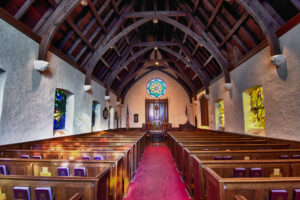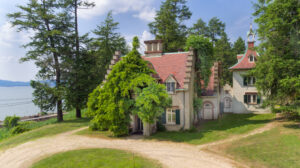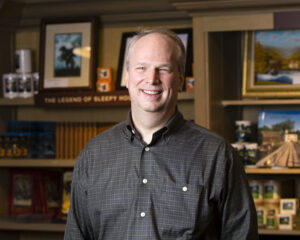
Arts and culture are some of the things that make the River Towns special. World-class venues and organizations like the Tarrytown Music Hall, Jazz Forum Arts, The Jacob Burns Film Center and Historic Hudson Valley – just to name a few – attract people from throughout the tri-state area and beyond to see world-renowned musicians, artists, films and cultural attractions. But groups like that rely on support from both audiences and governments to survive, and the future is uncertain for the latter.
With Donald Trump returning to office this month, many arts and cultural groups in our area are concerned. During President Trump’s first term, his budget proposals called for eliminating federal funding entirely for The National Endowment for the Arts (NEA) and the National Endowment for the Humanities (NEH). Fortunately, bipartisan support in Congress retained that funding. Now, the arts are losing a supportive administration and gaining one with a track record of being anything but. President Biden’s final budget included $210 million for the NEA alone – but what the future holds is anyone’s guess.
ArtsWestchester is one of the groups that’s concerned. It’s the largest private not-for-profit arts council in New York State. Since its founding in 1965, ArtsWestchester has provided more than $35 million to the arts and cultural community in Westchester. That group’s CEO Kathleen Reckling says: “While there is concern and anxiety, organizations also have to understand that we have to wait and see. It’s harder to do long-term planning, so we have to think more about how we might collaborate as a field.” She adds, “There is a lot of uncertainty in the air. We know what happened the first time.” Reckling also says the organizations it supports will be impacted – as will ArtsWestchester, “NEA funding directly supports us with $25,000 – $40,000/year. It allows us to commission local artists to show their work. Without their funding we would have to look elsewhere for that support. We also receive Humanities New York funding, and they get their money from the NEH, so there is a trickle-down effect.”

Reckling adds that the impact could also be felt even more deeply within our communities, “The concern is also that with the mandate the Trump Administration says it has, we anticipate a move away from Diversity, Equity, and Inclusion (DEI) initiatives, and many arts organizations do work to make sure diverse voices have space. So, there is concern about funding but also representation.”
Many of the blue-chip arts and cultural groups in the River Towns have received federal money. The Jacob Burns Film Center, Jazz Forum Arts and Historic Hudson Valley (HHV) are just a few. HHV says it “educates and entertains more than 300,000 visitors a year through school programs, tours of five National Historic Landmarks, and popular events like The Great Jack O’Lantern Blaze.” Those landmarks are right in our backyard – Kykuit, The Rockefeller Estate, Philipsburg Manor, Washington Irving’s Sunnyside, Union Church of Pocantico Hills, and Van Cortlandt Manor. And HHV receives support from both ArtsWestchester and Washington. But that support is not guaranteed into the future, and arts groups are bracing for what the Trump administration will do.

“The financial resilience of arts and culture groups may be tested, potentially quite soon. We all need to become careful risk managers, at least until we have clear sightlines into the new political landscape,” says Waddell Stillman, president of Historic Hudson Valley. And with HHV, Stillman says the figures we’re talking about are far from insignificant, “HHV has $1.5 million in “awarded” federal grants for five projects, the largest of which, $630,000, is from the National Park Service. The next in size are from the NEH, a $439,000 challenge grant and a $119,000 summer 2025 institute grant to train K-12 teachers in teaching hard history. All these federal grants involve reimbursing expenses incurred by the non-profit on a “look-back” basis, meaning that if the funding disappears, the nonprofit may be left holding the bag.”
Stillman adds, “We are guessing and hoping – and actively slow-walking projects to minimize spending and thus reduce the risk of incurring expenses we cannot recover.”
All of this raises one big question, can the state and local governments step in, if Washington ramps down its arts funding? Reckling says the political climate here is supportive. “Both New York State and Westchester have shown that they recognize that the arts matter, and they are committed to supporting nonprofits across sectors. We feel a little more comfortable knowing that we are here and getting that kind of support.” She adds, “All the electeds I have spoken with get it, and they understand that the arts are also an economic driver. They also value that the arts are fundamental to our communities and impact sectors outside the arts. Many of the groups also have educational programs and also work to provide programming that supports mental health and community betterment.”
But Stillman says the money from Washington is simply too much to replace, “There’s no way local funding could fill the void if federal sources dry up. Some of the support we receive from the state actually re-grants federal funds.” But he also says there are some hopeful signs out of the nation’s capital. “Arts and humanities funding is a MAGA target, but it’s also popular with some Republicans in the House whose districts benefit.”
Reckling adds there’s some reason for optimism. “There is uncertainty but it’s not all doom and gloom … people feel these places are important, and that is our beacon of hope.”
PHOTO: Waddell_Stillman_10
CAPTION: ‘There’s no way local funding could fill the void if federal sources dry up.’ – Waddell Simpson, president of Historic Hudson Valley. Photo supplied
PHOTO: Union-Church-Jaime-Martorano
CAPTION: Union Church of Pocantico Hills is one of five National Historic Landmarks managed by Historic Hudson Valley. Photo by Jaime Martorano






